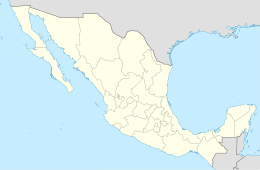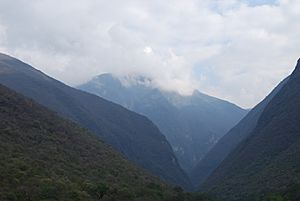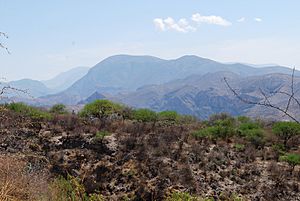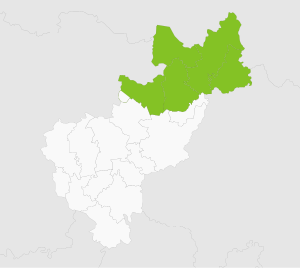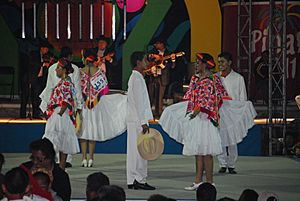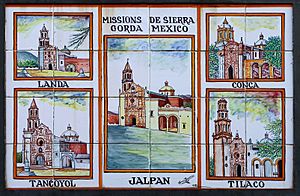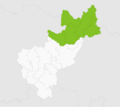Sierra Gorda facts for kids
Quick facts for kids Sierra Gorda |
|
|---|---|
|
IUCN Category Ia (Strict Nature Reserve)
|
|
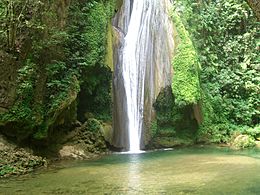
Waterfall in the Sierra Gorda, 2007
|
|
| Location | Querétaro, Mexico |
| Nearest city | Jalpan de Serra |
| Area | 383,567 ha (947,810 acres) |
| Established | May 19, 1997 |
| Governing body | National Commission of Protected Natural Areas (CONANP), Secretariat of the Environment and Natural Resources (SEMARNAT). |
The Sierra Gorda is a special natural area in Mexico. Its name means "fat mountains" because it has many tall, rugged mountains and deep valleys. This region is mostly in the state of Querétaro, but it also reaches into Guanajuato, Hidalgo, and San Luis Potosí.
The Sierra Gorda is famous for its amazing variety of plants and animals. This is because the mountains create many different mini-environments. Some parts are wet and green, like forests, while others are dry and look like deserts. A big part of this area is protected as a biosphere reserve to keep its nature safe. It's also home to old Franciscan Missions in the Sierra Gorda of Querétaro, which are a World Heritage Site.
Contents
- Exploring the Sierra Gorda's Geography
- Sierra Gorda's Climate and Weather
- Amazing Ecology of the Sierra Gorda
- Protecting the Sierra Gorda: Biosphere Reserves
- Challenges in Conservation
- People and Culture of the Sierra Gorda
- Important Towns and Settlements
- A Look Back: History of the Sierra Gorda
- The Famous Franciscan Missions
- Ancient Sites: Archeology in the Sierra Gorda
- Images for kids
- See also
Exploring the Sierra Gorda's Geography
The Sierra Gorda is part of a larger mountain range called the Sierra Madre Oriental. Its mountains were formed about 240 million years ago. Many of them are made of limestone, which came from ancient sea beds. Over time, water has carved out many caves and deep pits, some hundreds of meters deep!
This area has very rugged land with steep mountains and deep canyons. The height of the land changes a lot, from just 300 meters above sea level in some canyons to 3,100 meters on the highest peaks. Because of these big changes in height and how much rain different areas get, the Sierra Gorda has a huge variety of plants and animals.
Three main rivers flow through the Sierra Gorda: the Santa María River, the Extoraz or Peñamiller River, and the Moctezuma River. These rivers often form natural borders between different states and towns. They all flow into the larger Pánuco River basin.
Sierra Gorda's Climate and Weather
The weather in the Sierra Gorda changes a lot depending on how high up you are. The mountains act like a wall against the moisture coming from the Gulf of Mexico. This means the eastern side of the mountains gets much more rain and has forests, even some rainforests. The western side, however, is much drier, with desert-like conditions and lots of cacti.
In the high mountain areas on the east, mornings are often cloudy and foggy. The most rain falls in the very northeastern parts of the region. The coldest months are December and January, and the warmest are April and May. Temperatures vary widely, from an average of 13°C in high places like Pinal de Amoles to 24°C in lower areas like Jalpan. Sometimes, it even snows in the highest parts!
Amazing Ecology of the Sierra Gorda
The Sierra Gorda is one of the most diverse natural areas in Mexico. It has a huge number of different plant and animal species. This is because of all the different micro-environments found here.
You can find many types of habitats, from pine and oak forests on mountain tops to banana and sugar cane fields in deep canyons. The eastern side has forests where trees lose their leaves, while the western side has deserts with cacti and dry bushes.
Some animals in danger of disappearing here include the jaguar, puma, black bear, green parrot, and the Humboldt butterfly. These animals are mostly at risk because of human activities. Some endangered plants are the giant biznaga cactus and the magnolia. monarch butterflies also visit this area on their long journey south for winter.
Sometimes, the forests face problems like tree diseases or pests, especially during dry periods. This can weaken the trees and make them sick.
Protecting the Sierra Gorda: Biosphere Reserves
To protect its amazing nature, large parts of the Sierra Gorda have been made into biosphere reserves. There are two main ones: one in Querétaro and one in Guanajuato.
Querétaro's Biosphere Reserve
The Sierra Gorda Biosphere Reserve in Querétaro was created in 1997. It's special because it was started by local environmental groups and people who wanted to protect their home. This reserve covers about 400,000 hectares, which is a huge area! It includes parts of several towns like Jalpan de Serra and Pinal de Amoles.
In 2001, UNESCO recognized this reserve as an important part of its "Man and the Biosphere" program. It's known for having incredible biodiversity, meaning it has many different kinds of life. In fact, it has 10 out of Mexico's 11 main types of ecosystems!
This reserve is home to over 2,300 types of plants. It also has 130 kinds of mammals, including six types of wild cats like jaguars and pumas, and even black bears. There are 360 bird species, which is more than 30% of all bird species in Mexico! Many of these species are endangered.
The reserve is managed by the government, but local communities also help. Many people who used to live here have moved away, which has actually helped the environment recover. Less farming and logging means nature can heal.
Guanajuato's Biosphere Reserve
A large part of the Sierra Gorda that extends into Guanajuato state was also made a biosphere reserve in 2007. This area covers 236,882 hectares. Only eco-tourism, research, and traditional activities that don't harm nature are allowed in its most protected parts.
This section of the Sierra Gorda has 84 plant species, 182 bird species, and 42 mammal species. The land is very rugged, creating many different small climates. You can find everything from tropical fruit areas in low canyons to pine forests on high mountains.
Challenges in Conservation
Protecting the Sierra Gorda is challenging because many people who live there are poor. This means balancing the need to protect nature with the need for people to make a living.
One big problem is illegal logging, where people cut down trees without permission. This happens a lot in some areas and can lead to rivers drying up and soil washing away. Even though there are strict laws, it's hard to stop everyone.
Droughts and pest outbreaks are also a problem. Dry weather weakens trees, making them easier targets for beetles and other pests. These problems are made worse by climate change.
To help, the government and other groups pay landowners who protect their land. They also promote eco-tourism, which allows people to visit and enjoy nature while supporting local communities.
People and Culture of the Sierra Gorda
The Sierra Gorda is home to several indigenous groups, like the Otomi in the east and the Pame in the north. Even though these groups are a small part of the population, their culture, especially the Huasteca culture, has a strong influence.
Huapango is a popular traditional music and dance style here, with festivals held in towns like Xichú and Pinal de Amoles. Most people live in small villages.
Many people in the Sierra Gorda face poverty. While tourism is growing, most still rely on farming, raising animals, and mining. Because of the lack of jobs, many young people move away, often to the United States. They send money back home, which helps their families but also brings new challenges like more trash. However, fewer people living in the area has also helped nature recover.
An exciting annual event is the "Escalera del Infierno" (Hell's Ladder) cycling race in March. It's a tough 137 km ride through the mountains!
Important Towns and Settlements
Jalpan de Serra is known as the "heart of the Sierra Gorda." It's the only city within the Querétaro biosphere reserve. It's surrounded by mountains and has charming cobblestone streets. Eco-tourism and visits to the old Franciscan missions are now important for its economy. There's also a museum here about the Sierra Gorda's history and nature.
Xichú in Guanajuato was founded in 1585 as a mining town. It has a varied landscape, from high mountains to low river canyons. Even though few indigenous people live here now, the Huasteca culture is still strong.
Zimapán is the largest city in the Hidalgo part of the Sierra Gorda. It's mainly a mining center, extracting metals and stones from the mountains. This area has been home to the Otomi people for a long time.
A Look Back: History of the Sierra Gorda
People have lived in the Sierra Gorda for thousands of years, starting as hunter-gatherers. Later, they began farming and building villages. The area became a busy place for trade and cultural exchange between different regions of Mexico.
Between the 6th and 10th centuries, cities like Las Ranas and Toluquilla grew. Their economy was based on controlling trade routes and mining cinnabar, a red mineral used as a pigment. This area was a main supplier of red pigment for ancient Mesoamerica.
Around the 11th century, these cities were abandoned. Scientists think this might have been due to climate change, which made the area drier, or other social changes. Hunter-gatherer groups, known as "Chichimecas," then moved into the area and stayed until the Spanish arrived.
The Spanish began to explore and settle parts of the Sierra Gorda in the 16th century, especially where there were minerals. However, the heart of the Sierra Gorda remained dangerous because the Chichimeca people fought against Spanish rule.
Missionaries, like the Augustinians and Franciscans, tried to convert the local people to Christianity. It was a difficult task because the indigenous people were often hostile, and there were no large cities to easily convert.
In the 1740s, the Spanish military finally defeated the Chichimeca Jonaz people, making the area safer. This allowed for the building of permanent missions.
Junípero Serra is famous for building five main Franciscan missions in the Querétaro Sierra Gorda starting in the 1750s. These missions were built by the Pame people under the guidance of Franciscan friars. Serra wanted to blend cultures, and the mission churches show this with their unique "Mestizo Baroque" style, combining Spanish and indigenous art. Serra spent eleven years here before moving on to California.
The missions suffered damage during the Mexican War of Independence and the Mexican Revolution. They were restored in the 1980s and 1990s and were declared a World Heritage Site in 2003.
Mining of cinnabar and mercury has a long history here, going back to ancient times. While most large mines closed by 2000, some small-scale mining still happens. Researchers believe this long history of mining has caused mercury pollution in the environment, which might be linked to health problems in the region today.
The Famous Franciscan Missions
The five Franciscan missions in the Sierra Gorda of Querétaro are a UNESCO World Heritage Site. They were built in the mid-18th century by Junípero Serra and other friars. These missions were meant to convert the local Pame people and open up new routes into other regions.
The churches are known for their beautiful and detailed main entrances, called portals. This style is called "Mestizo Baroque" because it mixes Spanish Baroque art with indigenous elements. The decorations often use bright colors and include native symbols like rabbits and jaguars. This was a way to teach the new religion while respecting local culture.
- The mission in Jalpan de Serra was built from 1751 to 1758. Its portal features images of the Virgin Mary and a double-headed eagle, showing the blend of cultures.
- Nuestra Señora de la Luz de Tancoyol has the most detailed decorations, with lots of plants and corn. It also features unique elements like mermaids with indigenous faces.
- San Miguel Concá is the smallest mission, probably finished in 1754. Its decorations include a rabbit and a double-headed eagle.
- San Francisco del Valle de Tilaco was built between 1754 and 1762. It's the best-preserved mission and has subtle, beautiful decorations, including four mermaids with indigenous features.
- Santa María del Agua de Landa was the last mission built, between 1760 and 1768. Its sculptures are considered some of the best, and its bell tower is very narrow.
After Serra left in 1770, the missions were eventually abandoned and suffered damage over time. They were restored in the late 20th century and recognized as a World Heritage Site in 2003.
Ancient Sites: Archeology in the Sierra Gorda
The Sierra Gorda has many ancient sites that tell us about the people who lived here long ago. The earliest villages were built by farmers who came from other parts of Mexico. They often settled near springs and small lakes.
The most important ancient cities were Las Ranas and Toluquilla. They were busiest between the 6th and 10th centuries. These cities controlled important trade routes and mined cinnabar, a valuable red pigment. This area was the main source of this pigment for all of Mesoamerica.
The buildings at these sites were often made of stone slabs and mud. Many were built on terraces cut into hillsides. While we don't know much about their specific religious beliefs, burials show they believed in an afterlife.
Archaeologists have been studying these sites since the 19th century. Today, there are over 400 known archaeological sites in the Sierra Gorda. Scientists are also studying ancient bones to see how mercury mining affected the health of people long ago. This research also helps understand modern mercury pollution in the area.
Images for kids
See also
 In Spanish: Sierra Gorda (México) para niños
In Spanish: Sierra Gorda (México) para niños


